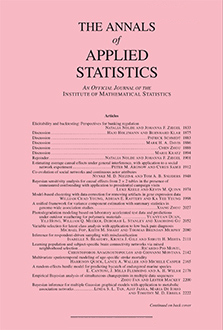Abstract
Obtaining an adequate description of the behaviour of narwhals in a pristine environment is important to understand natural behaviour as well as providing the means to determine potential changes in behaviour directly or indirectly caused by human activity. Based on $\text{Acousonde}^{\text{TM}}$ data from five narwhals in Scoresby Sound, this paper aims at modelling buzzing and calling rates of East Greenland narwhals as functions of time, space and, possibly, autoregressive memory. Both buzzing and calling are sounds produced by narwhals. Buzzing is a way for the whale to navigate and locate prey using echolocation, while calling is associated with social communication between whales. Logistic regression models without and with autoregressive components are compared based on AIC and comparatively assessed using diagnostics from point process theory. Adding an autoregressive component appears to improve the models, and further improvements for the buzzing model are made with a non-GLM extension. Effects of extrinsic covariates and memory are presented and interpreted. Buzzing occurs at deeper depths, and initiations of buzzes are separated by refractory periods. A possible feeding area is identified. Calling occurs closer to the surface, and, while the probability of calling in general is lower than buzzing, it is more likely that calls are clustered together rather than spread randomly.
Citation
Aleksander Søltoft-Jensen. Mads Peter Heide-Jørgensen. Susanne Ditlevsen. "Modelling the sound production of narwhals using a point process framework with memory effects." Ann. Appl. Stat. 14 (4) 2037 - 2052, December 2020. https://doi.org/10.1214/20-AOAS1379
Information





